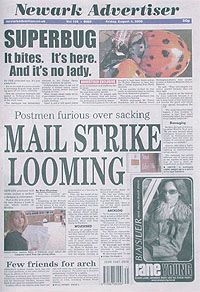

| Invertebrate news 2006 |
| Featuring news and sightings from Eakring |
| In most cases, clicking on the photos will link to larger images |
| Late insect sightings - Hare Hill Wood A warm November 6th, saw late singles of Red Admiral, Comma and Small Tortoiseshell butterflies along with a surprising Rusty Dot Pearl flushed from vegetation. Several Common Darters along the edge of the wood and numerous hoverflies including E.tenax and a single E.balteatus. 151 Harlequin Ladybirds were found, with many in active flight. | ||
| Second Harlequin Ladybird found The area's second Harlequin Ladybird, found at Lound Wood on October 19th 2006, shows how variable the species is. It was found in the car boot during a moth trapping session and is now believed to have been accidentally carried there, following a trapping session at Hare Hill Wood the previous evening. | ||
| Rusty Dot Pearl is 12th migrant species for 2006 The area's first Rusty Dot Pearl for six years and only the second ever record here, became the 12th migrant species to reach the area during 2006, when a male was taken at light from Lound Wood on October 10th. | ||
| Small Mottled Willow taken at light Migrants are still appearing, with a Small Mottled Willow being the latest new species for the area, taken at Lound Wood on September 17th. |  |
|
| Hornets again Two worker Hornets were attracted to an MV moth trap operated in Lound Wood on August 8th, indicating an active nest nearby. | ||
 |
Another search the next
day also proved fruitless. It is likely that this was a
one off sighting this time, although I firmly believe
that the Harlequin Ladybird is already at other sites in
Nottinghamshire. There was a report of one from an
Attenborough garden earlier this year, but the record was
unsubstantiated through lack of specimen or photographic
evidence and could not be accepted. It was found in Derby
in 2004 and that population has since spread away from
the initial location. The nearest publicised occurrences
to Nottinghamshire have been at Stanley in Derbyshire and
Grantham (Lincolnshire) Aside from a single record in
Lancashire in 2004, this seems to be the most northerly
sighting in the UK to date. They are a large species (see comparison with Seven-spot Ladybird in photo) and markings vary considerably, with many colour forms. The Harlequin Ladybird (Harmonia axyridis) was introduced into North America in 1988, where it is now the most widespread species. It has already invaded much of north-western Europe and arrived in Britain in the Summer of 2004. It is predicted to spread rapidly throughout the UK and there are worries that it may outcompete other ladybird species and is regarded as a major threat to them and some other insect groups. Left: How news of the Harlequin discovery made the headlines in the Newark Advertiser. |
|
| Hornets in the area again Hornets are once again present in the area this year, with a worker being recorded in Lound Wood on July 16th. | ||
| Broad-bordered Bee Hawk-moth An old record has recently surfaced
of what is probably Nottinghamshire's rarest resident
Hawk-moth - the Broad-bordered Bee Hawk-moth. Following a
conversation with an Eakring resident who has a long-time
interest in moths, the record (dating back to the 1980's)
concerned a young larva he found on Honeysuckle at the
Old School House in Eakring. The larva was successfully
reared and then released as an adult. The Broad-bordered Bee Hawk-moth is currently known to occur at only one site in Nottinghamshire, being only recently rediscovered there in 2005. |
||
| New Shieldbug Two adult Zicrona caerulea (known as the Blue Bug) represent another new insect for the Eakring area, when two were found and photographed at Eakring Flash on 19th May 2006. | ||